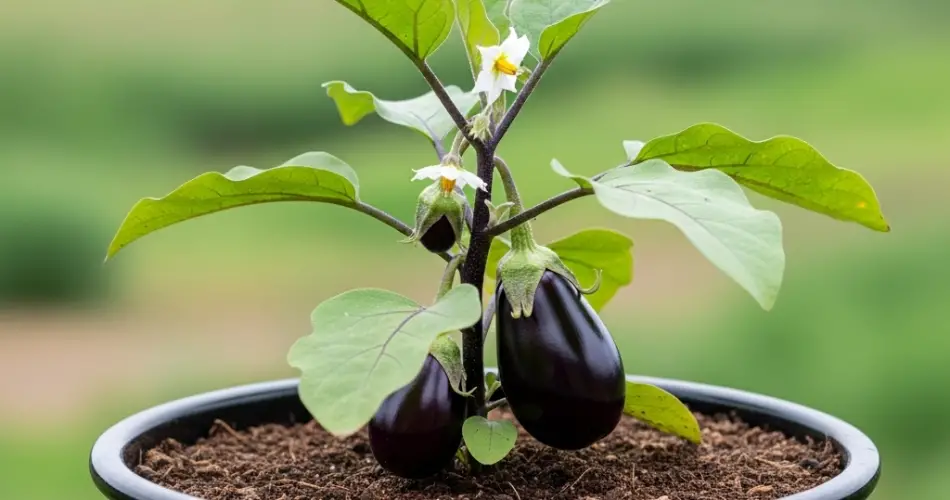Eggplants, also known as aubergines, are striking and productive plants that thrive in containers. With their glossy fruits, dramatic foliage, and compact growth habits, they’re a perfect addition to any small-space garden. Whether grown on a balcony, patio, or rooftop, potted eggplants can offer both beauty and a delicious harvest throughout the growing season.
These warm-weather vegetables are surprisingly easy to grow in pots, provided you give them the warmth, sunlight, and nutrients they crave. Here’s how to cultivate a vibrant and productive eggplant crop in containers.
Why Grow Eggplants in Pots?
Growing eggplants in pots offers several benefits:
-
Space efficiency: Perfect for small gardens or urban settings with limited ground space.
-
Mobility: Pots can be moved to catch the sun or protect from bad weather.
-
Pest management: Containers help isolate plants from soil-borne diseases and allow better control over pests.
-
Aesthetic value: Eggplants come in various colors and shapes, adding visual interest to container arrangements.
Even in tight quarters, a single plant in a large pot can produce a generous crop of fruits over the season.
Choosing the Right Variety
Some eggplant varieties are better suited to container growing than others. Look for compact or dwarf types that don’t require much staking or spreading space. Here are a few top picks:
-
Fairy Tale: A mini variety with purple-and-white striped fruits and a bushy habit.
-
Hansel and Gretel: Slender-fruited types that are compact and early to mature.
-
Patio Baby: Bred specifically for containers, this variety produces small, flavorful fruits.
-
Black Beauty: A classic heirloom with large, deep purple fruits—ideal for larger pots.
Choose based on your taste preference, climate, and container size. Smaller varieties are generally easier to manage in pots, especially in hot climates where space is limited.
Container and Soil Requirements
Eggplants have deep roots and need room to grow, so choose a pot that’s at least 12–14 inches deep and equally wide. Larger pots not only support better root development but also retain moisture more effectively.
Ensure your container has adequate drainage holes to prevent waterlogging. Terracotta, plastic, and fabric grow bags all work well. For multiple plants, use rectangular planters or barrels.
Use a high-quality potting mix enriched with compost or organic matter. Avoid using garden soil in pots, as it can be heavy and prone to compaction. A mix containing perlite or vermiculite improves drainage and aeration.
Planting and Spacing
Eggplants can be started from seeds indoors or planted directly as seedlings. If transplanting, wait until the weather is reliably warm—eggplants need consistent temperatures above 60°F (15°C) to thrive.
-
Plant one eggplant per pot unless using a large container.
-
Bury the seedling slightly deeper than it was in its original container to promote strong root development.
-
Firm the soil gently around the base and water thoroughly.
For maximum yield, start with healthy, hardened-off seedlings and avoid transplanting weak or leggy plants.
Sunlight and Temperature
Eggplants are heat lovers and need at least 6–8 hours of direct sun each day. Position pots in a bright, sheltered spot that receives full sun, such as a south-facing balcony or deck.
In cooler climates, placing pots near a wall or reflective surface can help raise the temperature around the plants. In hot climates, a bit of afternoon shade can protect them from scorching, especially during heatwaves.
If night temperatures drop below 55°F (13°C), consider covering your pots or moving them indoors.
Watering and Feeding
Eggplants in pots require consistent watering, especially during flowering and fruit development. Keep the soil evenly moist but not soggy. Containers dry out faster than garden beds, so daily checks are necessary in warm weather.
Mulching with straw or compost can help retain moisture and stabilize root temperatures.
Fertilize with a balanced liquid fertilizer every 2–3 weeks. Once flowers appear, switch to a low-nitrogen formula to encourage fruiting rather than leafy growth. Organic options like fish emulsion or compost tea work well throughout the growing season.
Supporting and Pruning
As eggplants grow and start to fruit, they may need staking or support to prevent bending or breakage. Use bamboo stakes, tomato cages, or small trellises to support the stems.
Light pruning helps improve air circulation and fruit development. Pinch off the first few flowers to encourage stronger root and branch growth. Remove any yellowing or damaged leaves as the season progresses.
Harvesting Your Eggplants
Eggplants are ready to harvest when the skin is shiny and firm, and the fruits have reached mature size. Don’t wait too long—overripe eggplants become bitter and spongy.
To harvest:
-
Use pruning shears or a sharp knife.
-
Cut the stem with a small portion attached to the fruit.
-
Handle fruits gently to avoid bruising.
Regular harvesting encourages the plant to produce more fruit. Most container-grown varieties will keep yielding for several weeks.
Final Tips for Success
-
Rotate pots weekly if sun exposure is uneven.
-
Protect young plants from flea beetles and aphids with row covers or neem spray.
-
Keep pots raised slightly off the ground to improve drainage and reduce pest risk.
With their bold foliage and colorful fruits, potted eggplants make a fantastic choice for any container garden. They combine ornamental beauty with culinary utility, proving that even in small spaces, you can grow a big harvest.



